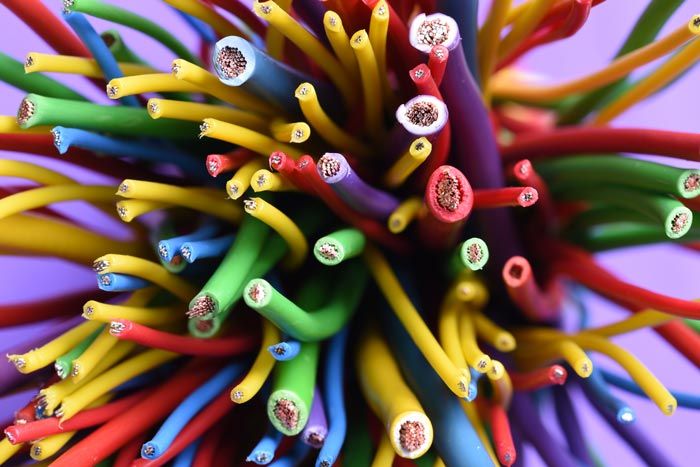What You Should Understand About Knob-and-tube Wiring
Admin • March 8, 2018
If your home was built before the 1940s, there is a good possibility it contains knob-and-tube wiring. Knob-and-tube wiring is a type of residential wiring used during the earliest days of the electrical industry and found it's way into millions of existing and new homes at the time.
Since that time, other wiring conventions replaced knob-and-tube wiring, such as non-metallic sheathed cable, and generally only remains in older homes that are not updated. Below is more information about knoband-tube wiring, including how to identify it, some of its disadvantages, and what you should do if you find it in your home.
The Basics of Knob-and-Tube Wiring
Instead of bundling all conductive wire strands together, knob-and-tube systems use separate, wired conductors to supply electricity. These strands are routed individually as deemed best by an installer, and unlike modern non-metallic sheathed cable, "hot" wires in a knob-and-tube system don't necessarily run parallel to neutral conductors. A fabric or rubber insulator wraps around each wire.
In a knob-and-tube system, each outlet and other fixed electrical installations are attached to separate "hot" and neutral wires via soldered splices. These connections are prepared by hand and require precision and patience for successful completion.
Knob-and-tube wiring consists of several unique components, including those that give the system its unique name. Ceramic insulators, known as knots, serve as anchor points for wire strands and are placed strategically wherever support is needed. The tubes, which are hollow ceramic pipes, protect wires from rubbing as they pass through studs and other structural components.
Another knob-and-tube wiring components include fabric looms that wrap around wires to prevent rubbing and possible short-circuits. Ceramic bushings perform a similar function as tubes by preventing fraying and excess wear on the wires as they enter junction boxes.
Disadvantages of Knob-and-Tube Wiring
Despite a common misconception, knob-and-tube wiring is not inherently dangerous if properly installed. In fact, it's ability to quickly dissipate heat energy is one of its strengths and can prevent potential electrical fires as a result. Well-made knob-and-tube systems can be expected to last many years.
However, knob-and-tube wiring does have a few disadvantages that make it effectively obsolete except in a few specialized applications. These include the following:
- Complex Wiring Layouts - The inconsistent routing of conductor wires throughout the home can make keeping track of wiring difficult. Complex drawings are needed to notate where there are wire routes since they often do not pair up, especially away from splices. As a result, troubleshooting wiring problems can be challenging.
- Expensive Installation - As mentioned, knob-and-tube wiring requires extensive patience and care during installation, as there are many time-consuming steps involved with its use. For example, wire splicing, tying, insulator attachments, and other operations greatly increase labor costs for installation.
- Electrical Code Changes - Knob-and-tube wiring is no longer permitted for new construction or installation in residential settings. Exceptions are generally only granted for certain industrial settings.
- Insurability Problems - Some insurance companies refuse to insure homes with knob-and-tube wiring or will raise the premium to high levels. This can drive up the cost of homeowners policies for those looking for affordable coverage.
It is important to contact a qualified electrician if you discover knob-and-tube wiring in your home. Their evaluation will enable you to know if the wiring is safe and sound, and they will also help make recommendations regarding its continued use or replacement.
As such, be sure to contact Express Electrical Service
for assistance with your knob-and-tube wiring. Their team of professionals is ready to assist you in making recommendations and can perform any necessary repair work for you.
Does your home fuse box need an upgrade? Read this blog to learn about six signs that indicate it’s time for an upgrade to protect your electrical system.
In this detailed article, we'll take a detailed look at some signs that your kitchen needs rewiring. Continue reading to find out more.
What types of electrical upgrades do you need to make before you list your home for sale? Take a look at the top electrical upgrades to consider.
There are several ways to protect your water mains and keep them in good condition. Discover three simple things you can start doing today.
Improving your office space is a great way to improve the workspace. Learn five critical services electricians offer during office remodeling projects.
A slab leak can cause more than just water damage to your home, especially in the summer. Read about the dangers of a slab leak by reviewing this blog.
As a property owner, you have certain responsibilities for the plumbing of your rental property. Learn professional tips by reading this blog.
Many homeowners have been bombarded with conflicting advice and outdated myths about plumbing. But no longer! Read our blog to learn about a few myths.
A major plumbing issue that constitutes an emergency is a water main break. Read this blog to learn about a main break’s causes, effects, and solutions.
You may be competent at fixing many home plumbing problems, but some issues require a professional hand. Here are 7 signs that indicate such a need.

